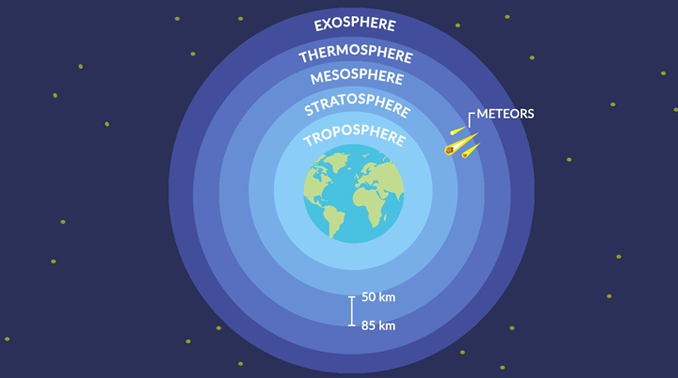Welcome to the fascinating world of the mesosphere! The mesosphere is one of the most important layers of Earth’s atmosphere, situated directly above the stratosphere and below the thermosphere. It extends from abut 50 to 85 km (31 to 53 miles) above our planet’s surface and is home to temperatures as cold as -90° C (-130° F).
The mesosphere has some pretty remarkable qualities. It serves as a shield, protecting us from meteors and other objects that enter our atmosphere at high speeds. This layer absorbs most of their energy and prevents them from reaching the ground. Without this important layer, life on Earth would be very different!
Not only does the mesosphere protect us, it also plays an important role in climate regulation. This layer reflects outgoing longwave radiation back into space, which helps maintain a consistent global temperature range over time. Additionally, moisture from lower levels can accumulate in this layer during winter months, creating brilliant displays of noctilucent clouds that are visible at night.
Despite being one of Earth’s most important layers, much about the mesosphere remains unknown to us. For example, scientists still aren’t sure why temperatures suddenly drop off so drastically at its uppermost limits—the mesopause—or why certain regions experience higher levels of turbulence than others. As technology advances, we may be able to answer these questions and learn more about this mysterious layer of our atmosphere!
Thanks for joining us on a journey into the captivating world of the mesosphere! With its protective powers and amazing features, this layer is certainly something worth exploring further.

Facts About the Mesosphere
1. The mesosphere is the layer of Earth’s atmosphere directly above the stratosphere and below the thermosphere. It extends from approximately 50 to 85 kilometers (31-53 miles) above the surface of the planet.
2. The temperature in the mesosphere decreases with height, reaching its coldest temperatures near its top at around -90° C (-130° F).
3. The mesosphere is home to some of Earth’s highest clouds, called noctilucent clouds, which form at heights between 80 and 85 km (50 and 53 miles). These clouds are made up of tiny ice crystals that reflect sunlight during twilight hours, giving them an eerie blue glow in the night sky.
The Benefits of Utilizing the Mesosphere Layer
The mesosphere is an atmospheric layer located between approximately 160,000 to 80,000 feet above sea level. It is the third highest layer of atmosphere and is located directly above the stratosphere and below the thermosphere. The mesosphere is a very cold region of the atmosphere with temperatures ranging from -90°C to -130°C (-130°F to -200°F). This layer is characterised by a lack of clouds and low air pressure, making it an ideal location for astronomical observation. The mesopause, which marks the top of this layer, is the coldest part of earth’s atmosphere. Within the mesosphere exists a region known as the mesopause inversion layer where temperatures rapidly increase with altitude instead of decreasing. This layer provides protection aginst meteors and other objects entering Earth’s atmosphere as most objects burn up before reaching this altitude. Additionally, this region contains some of Earth’s most spectacular displays of auroras.
Facts About the Mesosphere
1. The mesosphere is the third and coldest layer of Earth’s atmosphere, reaching temperatures of up to 130 degrees below zero.
2. It is located between the stratosphere and the thermosphere, extending from about 30 miles (50 km) to about 50 miles (80 km) above the surface of the Earth.
3. The mesosphere is home to a variety of meteors, or space rocks and metal, that burn up as they fall through it beore crashing to the ground.
4. It acts as a shield protecting our planet by slowing down and burning up most objects that enter its airspace before they can cause any damage on Earth’s surface.
The Importance of the Mesosphere
The mesosphere is the layer of the Earth’s atmosphere located directly above the stratosphere and below the thermosphere. It is the third-highest layer of the atmosphere, lying 50 kilometers above the surface. The mesosphere is important because it plays a vital role in protecting our planet from cosmic rays, meteorites, and other debris that would oterwise reach and harm Earth’s surface. It does this by burning up meteors and asteroids before they can enter the lower atmosphere. The mesosphere also helps to regulate global temperature by trapping infrared radiation that would otherwise escape into space. Additionally, it serves as an important source of data for scientists studying climate change and other aspects of our environment.
Can Planes Fly in the Mesosphere?
No, planes cnnot fly in the mesosphere. The mesosphere is the highest layer of Earth’s atmosphere and is located at an altitude of between 50 and 85 kilometers above the planet’s surface. This part of the atmosphere is extremely cold with temperatures ranging from -85 to -100 degrees Celsius. Additionally, the air in this layer is very thin, making it almost impossible for planes to generate enough lift to remain airborne. Furthermore, since this layer lies so far away from our planet, any aircraft attempting to fly through it would be exposed to extreme radiation coming from space. For these reasons, airplanes simply cannot fly in the mesosphere.
The Benefits of Using Mesosphere
The mesosphere is located about 30 miles above the Earth’s surface and is the third layer of the atmosphere. It is the coldest layer, with temperatures dropping as low as -140°F. In this layer, gas molecules are so far apart that thee is very little air resistance. As a result, meteors entering Earth’s atmosphere burn up in this layer, creating an impressive light show called a meteor shower. The gases in the mesosphere also absorb some of the ultraviolet radiation from the sun, helping to protect us from its harmful effects. Additionally, sound waves don’t travel very far in the mesosphere because of its lack of density. This means that thunderstorms can’t develop at this altitude and any thunder heard on Earth was actually created much lower down.
The Hottest Layer of the Atmosphere
The inner core is the hottest layer of the Earth, with temperatures estimated to reach up to 5,400 degrees Celsius (9,700 degrees Fahrenheit). It is composed mostly of iron and nickel and is held in place by immense pressure. Although it is hot enough to be liquid, it functions as a solid because of its dense environment. The heat within the inner core comes from the decay of radioactive elements, which continuously release energy in the form of heat. This heat is then transferred outward through convection currents in the molten outer core and mantle.
Characteristics of the Mesosphere
The mesosphere is a layer in the middle of Earth’s atmosphere that lies between the stratosphere and the thermosphere. It is characterized by cold temperatures, low air pressure, and very little moisture. The mesosphere typically begins at an altitude of about 50 kilometers (31 miles) above sea level and extends up to aound 85 kilometers (53 miles).
The most prominent feature of the mesosphere is its extremely low temperatures. Temperatures in this region can reach as low as -90°C (-130°F). This extreme cold occurs because there is very little air pressure in the mesosphere, which means that there is not enough air to trap heat from the sun. Consequently, radiation from the sun can only penetrate so far into this layer before it cools down drastically.
The mesosphere also has high winds, especially near its lower boundary with the stratosphere. These strong zonal winds usually move in an east-west direction and can reach speeds up to 300 kilometers per hour (186 miles per hour). This phenomenon is known as a jet stream. Additionally, atmospheric tides, internal atmospheric gravity waves (commonly called “gravity waves”), and planetary waves are all characteristic features of the mesosphere.
Overall, due to its extreme cold temperatures and high winds, the mesosphere provides a unique environment for various meteorological phenomena to occur.
Temperature of the Mesosphere
The mesosphere is a cold layer in the atmosphere, with temperatures dropping to an average of -90 ºC at its highest point. This is significantly colder than the temperatures found in other layers of the atmosphere, such as the stratosphere which can reach up to 30ºC. The mesosphere is also affected by atmospheric circulation and winds, creating even lower temperatures in certain areas. Due to its low temperature, the mesosphere is often referred to as the cold layer.
Objects Found in the Mesosphere
The mesosphere is an upper layer of the Earth’s atmosphere that lies between the stratosphere and the thermosphere. This region is somtimes referred to as the “middle atmosphere” due to its position in the atmospheric layers. In this layer, temperatures rapidly decrease with altitude, reaching lows of -100°C near the top of the mesosphere.
In this layer, you can find meteors burning up in streaks of light as they enter Earth’s atmosphere and break apart. Sprites, a type of lightning, can also be seen in this layer above thunderstorms. In addition, noctilucent clouds are high-altitude clouds that form near the North and South Poles. Finally, airglow—the faint emission of light from atoms and molecules in a planet’s atmosphere—can also be found here.
Composition of the Earth’s Mesosphere
The mesosphere is composed of oxygen, nitrogen and carbon dioxide. It is located in the middle atmosphere between the stratosphere and thermosphere. As the distance from the Earth increases, the mesosphere gets colder and colder, eventually reaching temperatures low enough to freeze water vapor into ice clouds. The density of gases in this layer decreases with increasing altitude, making it difficult for air to circulate. This makes it an excellent place for scientists to study atmospheric phenomena such as meteors and auroras.
The Causes of Cold Temperatures in Mesosphere
The mesosphere is situated high up in the atmosphere, between the stratosphere and the thermosphere. Due to its altitude, the mesosphere is exposed to less direct sunlight than lower atmospheric layers and thus receives less heat from the sun. Additionally, radiative cooling from carbon dioxide is strong in this region, causing temperatures to drop even lower. The lack of heat combined with the strong radiative cooling from carbon dioxide results in extreme cold temperatures in the mesosphere – as low as -100 °C (-148 °F or 173 K).
The Protection Provided by the Mesosphere
The mesosphere is a layer of Earth’s atmosphere located between the stratosphere and the thermosphere. It plays an important role in protecting us from cosmic radiation and meteoroids, such as asteroids and meteors. The density of the air in the mesosphere is so low that most meteoroids burn up before they reach the surface. This process is known as “ablation” and it allows us to avoid potential impacts that coud cause significant damage to our planet. Additionally, the mesosphere absorbs some of the energy from incoming solar radiation, shielding us from harmful ultraviolet rays. Finally, it helps regulate Earth’s temperature by trapping some of the heat from the stratosphere below it.
Can You Breathe in the Mesosphere?
No, you cannot breathe in the mesosphere. The air density in this layer of the atmosphere is much too low to provide enough oxygen for humans to breathe. In addition, the ozone layer that provides protection from ultraviolet radiation is located in the stratosphere below the mesosphere, so there would be very little protection from dangerous UV radiation. For these reasons, traveling through the mesosphere would be extremely hazardous and not conducive to human health.
The Coldest Layer of the Atmosphere
The coldest layer of the atmosphere is the mesosphere, which is located between 50 and 80 kilometers (31 and 50 miles) above Earth’s surface. In this layer, temperatures get progressively colder with altitude, with an average temperature of about minus 85 degrees Celsius (minus 120 degrees Fahrenheit) at the very top. This makes the mesosphere the coldest place found within the Earth system.
Conclusion
In conclusion, the mesosphere is an important layer of Earth’s atmosphere that protects us from space rocks and metal. It stretches from approximately 50 to 85 km (31 to 53 miles) above our planet and has the coldest temperatures in Earth’s atmosphere, reaching about -90° C (-130° F). The mesosphere plays an essential role in keeping our planet safe by burning up most meteors before they can crash to the ground. Without it, Earth would be vulnerable to potentially catastrophic impacts.












